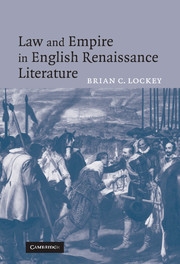Book contents
- Frontmatter
- Contents
- Acknowledgments
- Introduction: Romance and the ethics of expansion
- PART I ROMANCE AND LAW
- PART II THE PREROGATIVE COURTS AND THE CONQUEST WITHIN
- 5 Historical contexts: common law, natural law, civil law
- 6 Roman Conquest and English legal identity in Cymbeline
- 7 Love's justice and the freedom of Brittany in Lady Mary Wroth's Urania part I
- Conclusion: English law and the early modern romance
- Index
6 - Roman Conquest and English legal identity in Cymbeline
Published online by Cambridge University Press: 22 September 2009
- Frontmatter
- Contents
- Acknowledgments
- Introduction: Romance and the ethics of expansion
- PART I ROMANCE AND LAW
- PART II THE PREROGATIVE COURTS AND THE CONQUEST WITHIN
- 5 Historical contexts: common law, natural law, civil law
- 6 Roman Conquest and English legal identity in Cymbeline
- 7 Love's justice and the freedom of Brittany in Lady Mary Wroth's Urania part I
- Conclusion: English law and the early modern romance
- Index
Summary
Applying the term “romance” to Shakespeare's late plays is a relatively recent phenomenon. Samuel Coleridge called The Tempest a “romance” in his Notes on “The Tempest”, and later in the original Arden edition of Cymbeline, Edward Dowden clarified the term's use: “In all [these plays] there is the same romantic incident of lost children recovered by those to whom they are dear – the daughters of Pericles and Leontes, the sons of Cymbeline and Alonzo. In all there is a beautiful romantic background of sea and mountain. The dramas have a grave beauty, a sweet serenity.” As many subsequent scholars have done, Dowden was seeking to justify grouping the late plays under one rubric by attending to the formal characteristics that they hold in common. But his attribution of shared elements reminds us that these plays are only distinct from the rest of Shakespeare's corpus insofar as they share these same elements with the period's prose and verse romances. Conventional narratives such as that of the orphaned prince or princess whose true identity is concealed and then discovered (and sometimes confirmed by the existence of a birthmark) are ubiquitous in the prose and verse romances of the period. Such elements shared by both dramatic and “true” romances explain why it is entirely appropriate to consider a Shakespearean romance in a study of this nature.
- Type
- Chapter
- Information
- Law and Empire in English Renaissance Literature , pp. 160 - 186Publisher: Cambridge University PressPrint publication year: 2006



